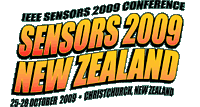

|
Tutorials Micro-Optic and Fiber Optic Sensors Terahertz Sensing Noise Harvesting Chemical and Gas Sensing Industrial Tomography Silicon Piezoresistive Stress Sensors Miniaturised Space Payloads Integrated Gas Sensors Sensors as Communication Channels Nanophotonic Sensors Biopolymer Detection Integrated Radar Sensors Ultrasonics |
Description of tutorial scope: 1. Polymers (molecular weight, spatial structure, properties) 1.1. Dental polymers 1.2. Biopolymers 1.2.1. Nucleic acids 1.2.2. Human blood plasma proteins. 1.2.3. Polysacharides 2. Electric and Magnetic Properties of Nucleic Acids 2.1. Electric properties 2.1.1. Electronic charge distribution 2.1.2. Interactions of bases, nucleosides and nucleoti¬des with ions 2.1.3. Forces stabilizing double helical conformation of DNA and synthetic polynucleotides 2.1.4. Electric field effects on DNA 2.2. Magnetic properties 2.2.1. Diamagnetic anisotropy 2.2.2. Degree of orientation of nucleic acids in magne¬tic field 3.Sensing of biopolymers interaction with surfaces by electrochemical methods. 3.1. Electrocapillary curves, potential of electrocapillary maximum. 3.2. Electrode double layer. 3.3. Electrochemical methods and instrumentations. 3.3.1. Polarography. 3.3.2. Impedance measurements, electrochemical impedance spectroscopy. 3.3.3. Measurement of electrocapillary curves. 3.4. Adsorption 3.4.1. Effect of adsorption on electrocapillary curves 3.4.2. Adsorption isotherms. 3.5. Two-dimensional condensation, Avrami equation. 3.6. Electrochemical properties of nucleic acids. 3.6.1. Faradayic properties, reduction, oxydation. 3.6.2. Tensammetric properties. 4. Sensing of biopolymers interaction with surfaces by optical methods - difraction optical element (DOE). 5. Titanium implants: 5.1. Interaction of metal with tissues 5.2. Adsorption of human blood plasma proteins on the titanium surrface. Biography
PUBLICATIONS: More than 60 scientific publications, 4 review papers in monographies. According to WOS: h-index 17, number of citations 1083. |
|||||||||||||||||||||||||||||||||
Copyright 2008, All Rights Reserved, IEEE Sensors 2009 and interteq.com